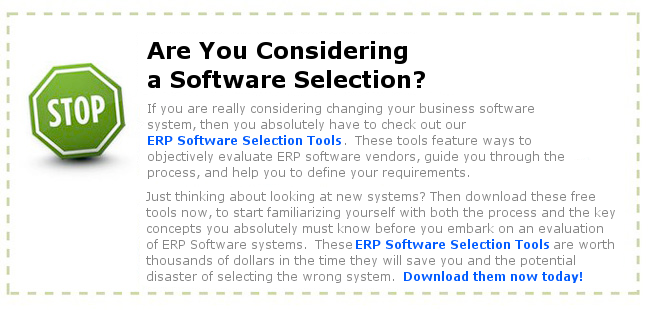[ReviewAZON asin=”1891865056″ display=”fullpost”]
Tag: Technology
ERP on Tablet PCs
ERP on Tablet PCs is Now!
ERP on Tablet PCs is here now. Earlier we did an article on ERP on the iPad. With the amazing pace of technology, people can now use mobile platforms for accessing their corporate data. For some people, the iPad is a great tool, but others may have different views on using the iPad. Now there is an alternative. Small form factor Tablet PCs are available. Some of these are Windows-based and others are Android OS-based.
Imagine being a salesperson on the road and being able to review a customer account before the big meeting right from your car. Or during the meeting, being able to check stock on a particular item for the client right in their office! These are now completely realistic scenarios. Allowing the ERP on Tablet PCs to be a reality today.
Of course, it will have to gain support of the IT departments who are holding security as one of the highest priorities. Issues such as security will need to be addressed on a company-by-company basis to ensure that the corporate data is still well protected. But many companies are providing this data already on a web enabled portal, which would be perfect for ERP on a Tablet PC scenario.
We are seeing a lot of iPhone and Android apps being made for the phones, but these apps will also run ERP on Table PCs as well. So within a few years we should see a lot more of these apps available from all the major ERP vendors.
Here is a video review of the ViewSonic ViewPad 7 that will give you an idea of how powerful these technologies are now and it will give you an idea of how you will soon see ERP on the Tablet PCs.
ERP on Tablet PCs – ViewSonic Video Review
Click on the video to find out more information.
File as: ERP on Tablet PCs
ERP System
ERP System
“ERP System” is a way of describing Enterprise Resource Planning. An ERP System is a set of people, process and technology that enable an business to optimize and fully utilize all of their resources. So often people think of an ERP System as simply a software package. But it is much more. Let’s look at some of the aspects of a true ERP System.
ERP System Explained
If you consider all of the aspects of an ERP System, you must look at the parts of the business from a process perspective. Take for example a process of “Order-to-Cash”. This process follows the concept of taking an order for a product, checking and requisitioning inventory, preparing it for shipment, and shipping it out. Then it is invoiced, and ultimately the invoice is paid.
If you map out the Order-to-Cash process in your organization, you will likely find a lot of inefficiencies. You don’t want to automate these inefficiencies. That would only make the inefficiencies faster. So you should first look at the system of people, processes and then ultimately automate it with technology.
So your ERP System is all of the inputs and outputs to the process of taking an order and processing it through until your receive payment for that order. Take for example the Order process. The input is the order itself. The output may be the printed order or the picklist for pulling the inventory. This order is input and processed by an order entry clerk. You can see in this simple example the process of taking the order (input) and generating a picklist (output) as the first step in your order-to-cash processs.
Where possible an ERP System drives data inputs to their source. That is why Internet-based shopping carts and order systems are becoming essential. The customer is the source of the data, so they should be the source of the input into the system. You can see the beginning of a supply chain where the customer pulls inventory from the company, who then pulls inventory from a supplier. This customer, processor, supplier model repeats again and again, in both a micro level and a macro level. The order entry station is the micro level processor in the above example, and the distribution company is the macro level processor in the larger picture. You can take any process and look at the input (or the customer pull) and see what makes up the transaction, and who is the supplier for the process.
The ERP System is a many operational and financial processes that are run by people to fulfill the supply and demand of the process and ultimately streamlined and enabled by technology
Steps to improving your ERP System before automating
There are a number of things you can do, but the obvious first thing is to identify your processes and systems. Tools such as Lean Enterprise (or Lean Manufacturing) can help you reduce and eliminate waste in your processes. Based on the Toyota Production system, Lean is a very effective way to reduce wasted efforts, reduce costs, and improve your throughput.
Another area to look at is improving quality. Quality methods and tools can greatly increase your bottom line when properly applied. ISO9000 and similar certifications are both effective at communicating a message internally and externally, that only high quality products and services will be tolerated.
Scaling these two system improvements upon a well matched business software system will create a world-class organization. Key to finding a software to support your ERP System is matching your processes and key functions to an ERP Software solution.
Resources for Improving your ERP System
The first thing you should check out is ERPandmore.com’s free ERP System Tools that you can download. These can help you better define functions within an ERP system, Vendor Evaluations, and compare competing solutions.
Some other resources you should look to include the American Production and Inventory Control Society and the Quality Management Institute. These two organizations have a lot of publications and information about business process improvement.
With regards to the software for your ERP System, you can find a multitude of vendors in our ERP Software Directory. You can also find ERP Vendor reviews and get price quotes from SoftwareAdvice.com.
ERP System
Revealing The Way Information Security Management Can Help Make Sure The Safety Of Your Firm’s Files
It is, possibly, regrettable but information security management has now become completely vital in the modern business world given just how probable harmful IT attacks have become on a everyday basis. Information security management is a vital type of technology when it comes to assisting businesses evaluate and, in due course, protect themselves against the all too regular attacks on the vulnerable data which they may be storing.
Information security management will generally be accountable for elements like the security of data and making sure that it cannot be compromised by harmful codes or IT based attacks. Knowing the way in which businesses are vulnerable to infiltration isn’t always simple given the speed with which harmful technology can alter and, as such, integrating information security management solutions is imperative for a company in order to achieve the belief of their consumers or clientele.
Itscm and Information Security Management
Keeping Your Data Safe
Maintaining the integrity of company data is something which is vital for companies of all size and shapes and, in order to facilitate this, the majority will speak to infrastructure solution experts about the proper way of integrating information security management into their everyday functions. Naturally, a company will make the huge majority of its business judgements based on the information that they accumulate and because of this fact, it is very critical that this data and material is sufficiently protected from being infected or compromised in any way.
Any corporation that has experienced a breach of their security or had their data compromised in any way are likely to say just how difficult it demonstrated to be. As such, making sure that this doesn’t transpire in the beginning is likely to be a key target for hundreds of businesses each year and using information security management technology is almost always the weapon of choice when it comes to helping ensure the security of sensitive business data.
The quantity of businesses which are still not adequately protected from the concern of data breaches or malicious attacks is still comparatively high but increasingly more are now coming to realise that the implications can be devistating if they don’t make sure they shield sensitive data. information security management software is normally precisely tailored to different market sectors and speaking to specialists in the area of infrastructure solutions is something which is likely to prove very useful and economical.
 |
Management of Information Security |


